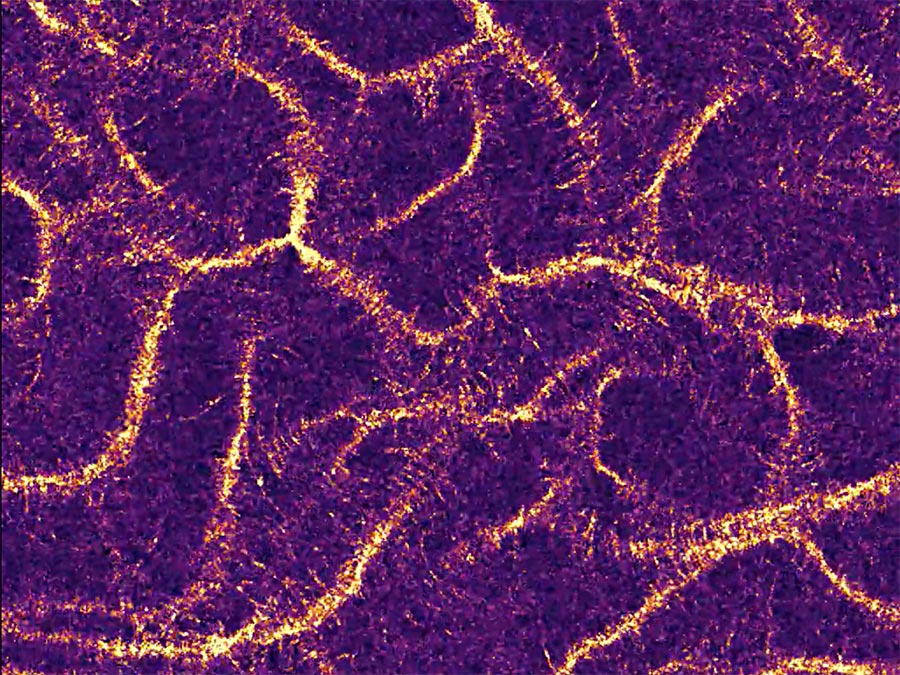Patterning of active systems provides new insights into biophysical processes
Wave fronts and ant trails

Bird flocks and bacterial suspensions, but also the dynamic filamentous protein systems that make up the cytoskeleton of eukaryotic cells, have something in common. From the physicist’s point of view, these are all examples of active matter, i.e. systems whose components are capable of converting chemical energy into active motion.
How these components self-organize into functional assemblies is one of the central problems in cell biology. Investigating an active model system a team led by professor Andreas Bausch, Technical University of Munich (TUM) and professor Erwin Frey, Ludwig-Maximilians-Universität (LMU), discovered unique patterning phenomena.
First of all, the researchers found that distinct patterns can emerge under the same starting conditions and, furthermore, these ordered states can dynamically coexist with one another. Secondly, subtle fluctuations on the microscopic level do not die away. Instead they can have significant consequences for the whole system at the macroscopic level.
The “flying carpet”
The scientists used a standard motility assay as their model. In this system, myosin motor proteins are attached to a substrate to form a kind of carpet. Then a solution containing filamentous polymers of the protein actin in added. In the presence of a chemical energy source (ATP), the filaments bind to the motor proteins and are actively transported within the array.
“Under standard conditions, the actin filaments move in wave-like clusters,” says Lorenz Huber, a doctoral student in Frey’s group and, together with Ryo Suzuki and Timo Krüger, joint first author of the paper.
Small change, big effect
Experiments performed in Bausch‘s laboratory showed, however, that minor alterations in the interactions between the proteins have an unexpected effect on this pattern. Addition of a small amount of the organic polymer polyethylene glycol to the system effectively reduces the volume available to the actin filaments. Under these conditions, not only the frequency, but also the type of interactions observed changes markedly, and the advancing wave fronts are transformed into thread-like forms that grow in length, rather like ant trails.
This demonstrates that even minor, local modifications can drastically alter the behavior of the system at the macroscopic level. “Normally, one assumes that the tiny details become insignificant at larger scales – but here, small differences are progressively amplified and have an ever-larger impact as one increases the scale of the system,” says Bausch.
Dynamic interplay
The researchers went on to develop a theoretical model that captures the motions of the filaments and reproduces the experimental observations. Simulations based on this model also revealed a region of parameter space in which both wave-like structures and ant-trails emerge simultaneously – and can stably coexist with each other.
“This emergence of bistability indicates that we have identified a new phase of matter,” says Frey. In further laboratory experiments, the team was in fact able to generate both states of organization at once. The polarized waves wash over the ant-trails and virtually wipe them out, leaving behind a kind of moraine, which serves to seed the formation of a new ant-trail. So the system exhibits a dynamic interaction between the two types of pattern.
These findings indicate that active matter systems have a unique capacity to give rise to different sorts of dynamic patterns under identical starting conditions. According to the study’s authors, this insight has profound implications for various fields of research, and could lead to new ways of understanding biological processes.
Publication:
L. Huber, R. Suzuki, T. Krüger, E. Frey, and A.R. Bausch
Emergence of coexisting ordered states in active matter systems
Science, 28 Jun 2018, eaao5434 – DOI: 10.1126/science.aao5434
Further information:
The work was funded by the European Research Council (Advanced Grant SelfOrg) and the German Research Foundation (DFG) via the SFB 863 and the Cluster of Excellence Nanosystems Initiative Munich (NIM).
Contact:
Prof. Dr. Andreas Bausch
Technical University of Munich
Chair of Cellular Biophysics (E27)
James-Franck-Str. 1, 85747 Garching, Germany
Tel.: +49 89 289 12480
andreas.bausch@ph.tum.de